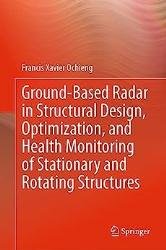Ground-Based Radar in Structural Design, Optimization, and Health Monitoring of Stationary and Rotating Structures
- Добавил: literator
- Дата: 19-06-2023, 06:16
- Комментариев: 0
 Название: Ground-Based Radar in Structural Design, Optimization, and Health Monitoring of Stationary and Rotating Structures
Название: Ground-Based Radar in Structural Design, Optimization, and Health Monitoring of Stationary and Rotating StructuresАвтор: Francis Xavier Ochieng
Издательство: Springer
Год: 2023
Страниц: 227
Язык: английский
Формат: pdf (true)
Размер: 17.6 MB
This book provides a practical application for using ground-based radar (GBR) as a remote (non-contact) sensor for structural health monitoring (SHM) in the development of sustainable and robust stationary and rotating structures, such as beam-like bridges, towers, wind turbines, and hydropower turbines. It integrates cutting-edge research into an easy-to-understand approach for non-radar and monitoring specialists, building on the methods and theory of working with radar systems, SHM frameworks, GBR signal processing, and validation techniques. All aspects of in-field monitoring and use during the design and testing of structures are covered, including data acquisition and processing, damage detection techniques, and damage prognostic techniques. The book is a hands-on reference that provides critical information on GBR for practitioners, university instructors, and students involved in structural design, optimization, and health monitoring of stationary and rotating structures.
The three-tier Structural Health Monitoring (SHM), particularly of renewable energy systems with rotary movements, presents one of the unique challenges with these energy generators like wind turbines and hydropower systems from the point of non-contact sensors. The need for such non-contact sensors arises due to metrological features like vertical gradients in the wind (or water current) speeds and direction, as well as turbulence intensity. These are becoming more decisive in the design and deployment of wind turbines (WT), ocean and tidal power systems, and hydropower systems.
Such needs have subsequently fuelled a need for new measurement techniques to collect the specific parameters for structural health monitoring (SHM) of the mast, turbines and blades. Importantly, it has led to an increase in non-contact measurement techniques as well as the need for better-validated modelling techniques that address problems of (a) flutter and (b) type and component certification of blades, turbines, and masts. One such novel approach is the use of ground-based radar (GBR) as a non-contact SHM sensor.
GBRs are increasingly being used either as vibration-based or as guided-wave-based SHM sensor for monitoring of blades, turbines, and masts components. This book contributes to the monitoring of these components during design, testing, and in-field operation. The optimal monitored condition parameters (CPs) that the GBR can utilize are identified as the component modal frequencies and deflection at component blade tips and tower/masts nacelle.
The book seeks to enhance knowledge and skills as well as address research gaps with the subsequent novelty to be addressed, including: First, an apparent lack of singular studies that consider a portable GBR for SHM of in-field blades and masts of level 1 damage detection while the, for example, the WT is operating under theoretically normal conditions under international IEC standards 61400-1 Design load conditions (DLC) 1.1.–1.5. Secondly, the apparent lack of studies for utilizing GBR under the SHM framework for components operating in actual conditions. A clear rationale is provided by previous studies (and not under the SHM framework) that focussed on WT in a parked position or under laboratory set-ups but not under actual conditions.
This book thus seeks three primary objectives: (a) to provide an understanding of how ground-based radar works (theory of ground-based radar); (b) to entrench the use of the three-tier SHM (structural health monitoring) framework in the context of non-contact sensors; and (c) to provide application or use cases for GBR in areas of civil engineering, energy, and human health. On a secondary level, the book using Wind Turbines (WT) as a specific case study seeks (i) GBR determination of the two SHM condition parameters (CPs), modal frequencies and flapwise deflection, for an operating in-field wind turbine blade and masts, and (ii) integration of GBR into the three-tier framework and its validation thereof. In achieving these objectives, a conceptual framework cognizant with type and component certification for the blade and mast design (IEC 61400-1, IEC 61400-2) and full blade SHM under IEC 61400-23 is utilised.
Contents:
Скачать Ground-Based Radar in Structural Design, Optimization, and Health Monitoring of Stationary and Rotating Structures
[related-news] [/related-news]
Внимание
Уважаемый посетитель, Вы зашли на сайт как незарегистрированный пользователь.
Мы рекомендуем Вам зарегистрироваться либо войти на сайт под своим именем.
Уважаемый посетитель, Вы зашли на сайт как незарегистрированный пользователь.
Мы рекомендуем Вам зарегистрироваться либо войти на сайт под своим именем.

